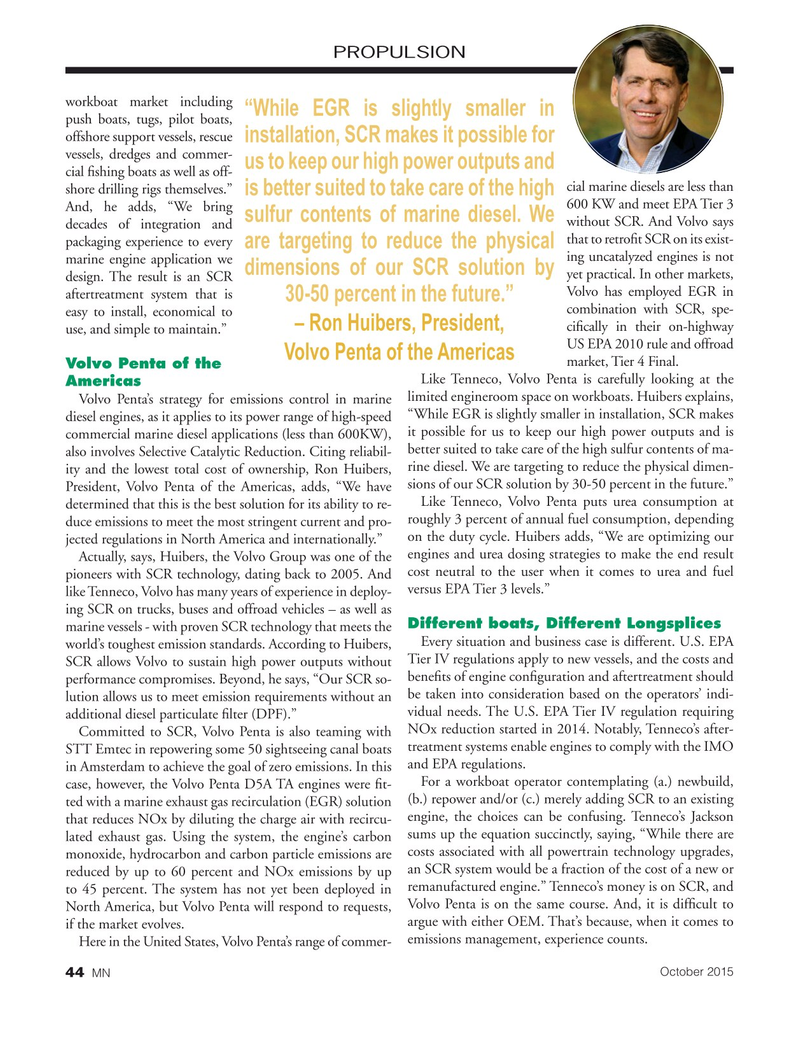
Page 44: of Marine News Magazine (October 2015)
Salvage & Spill Response
Read this page in Pdf, Flash or Html5 edition of October 2015 Marine News Magazine
PROPULSION workboat market including “While EGR is slightly smaller in push boats, tugs, pilot boats, offshore support vessels, rescue installation, SCR makes it possible for vessels, dredges and commer- us to keep our high power outputs and cial ? shing boats as well as off- cial marine diesels are less than shore drilling rigs themselves.” is better suited to take care of the high 600 KW and meet EPA Tier 3
And, he adds, “We bring sulfur contents of marine diesel. We without SCR. And Volvo says decades of integration and that to retro? t SCR on its exist- packaging experience to every are targeting to reduce the physical ing uncatalyzed engines is not marine engine application we dimensions of our SCR solution by yet practical. In other markets, design. The result is an SCR
Volvo has employed EGR in aftertreatment system that is 30-50 percent in the future.” combination with SCR, spe- easy to install, economical to – Ron Huibers, President, ci? cally in their on-highway use, and simple to maintain.”
US EPA 2010 rule and offroad
Volvo Penta of the Americas market, Tier 4 Final.
Volvo Penta of the
Like Tenneco, Volvo Penta is carefully looking at the
Americas
Volvo Penta’s strategy for emissions control in marine limited engineroom space on workboats. Huibers explains, diesel engines, as it applies to its power range of high-speed “While EGR is slightly smaller in installation, SCR makes commercial marine diesel applications (less than 600KW), it possible for us to keep our high power outputs and is better suited to take care of the high sulfur contents of ma- also involves Selective Catalytic Reduction. Citing reliabil- ity and the lowest total cost of ownership, Ron Huibers, rine diesel. We are targeting to reduce the physical dimen-
President, Volvo Penta of the Americas, adds, “We have sions of our SCR solution by 30-50 percent in the future.”
Like Tenneco, Volvo Penta puts urea consumption at determined that this is the best solution for its ability to re- roughly 3 percent of annual fuel consumption, depending duce emissions to meet the most stringent current and pro- on the duty cycle. Huibers adds, “We are optimizing our jected regulations in North America and internationally.”
Actually, says, Huibers, the Volvo Group was one of the engines and urea dosing strategies to make the end result pioneers with SCR technology, dating back to 2005. And cost neutral to the user when it comes to urea and fuel versus EPA Tier 3 levels.” like Tenneco, Volvo has many years of experience in deploy- ing SCR on trucks, buses and offroad vehicles – as well as marine vessels - with proven SCR technology that meets the Different boats, Different Longsplices
Every situation and business case is different. U.S. EPA world’s toughest emission standards. According to Huibers,
SCR allows Volvo to sustain high power outputs without Tier IV regulations apply to new vessels, and the costs and bene? ts of engine con? guration and aftertreatment should performance compromises. Beyond, he says, “Our SCR so- lution allows us to meet emission requirements without an be taken into consideration based on the operators’ indi- vidual needs. The U.S. EPA Tier IV regulation requiring additional diesel particulate ? lter (DPF).”
Committed to SCR, Volvo Penta is also teaming with NOx reduction started in 2014. Notably, Tenneco’s after-
STT Emtec in repowering some 50 sightseeing canal boats treatment systems enable engines to comply with the IMO in Amsterdam to achieve the goal of zero emissions. In this and EPA regulations.
For a workboat operator contemplating (a.) newbuild, case, however, the Volvo Penta D5A TA engines were ? t- ted with a marine exhaust gas recirculation (EGR) solution (b.) repower and/or (c.) merely adding SCR to an existing engine, the choices can be confusing. Tenneco’s Jackson that reduces NOx by diluting the charge air with recircu- lated exhaust gas. Using the system, the engine’s carbon sums up the equation succinctly, saying, “While there are monoxide, hydrocarbon and carbon particle emissions are costs associated with all powertrain technology upgrades, reduced by up to 60 percent and NOx emissions by up an SCR system would be a fraction of the cost of a new or to 45 percent. The system has not yet been deployed in remanufactured engine.” Tenneco’s money is on SCR, and
North America, but Volvo Penta will respond to requests, Volvo Penta is on the same course. And, it is dif? cult to argue with either OEM. That’s because, when it comes to if the market evolves.
emissions management, experience counts.
Here in the United States, Volvo Penta’s range of commer-
October 2015
MN 44
MN Oct15 Layout 32-49.indd 44 9/21/2015 11:27:07 AM

 43
43

 45
45
